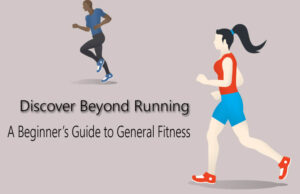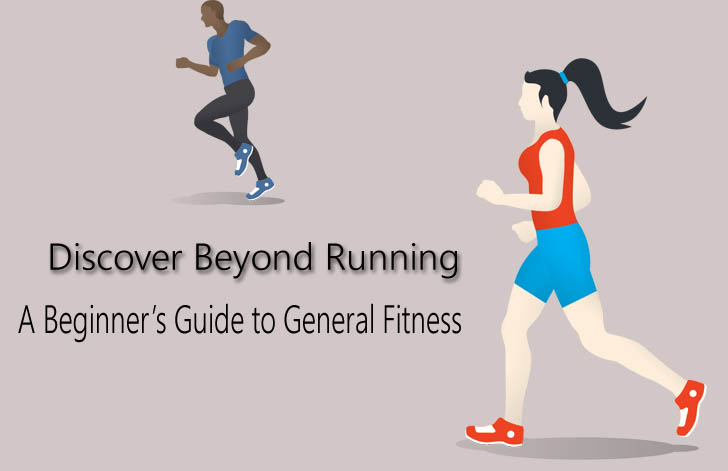From Couch Potato to Marathon Runner: A Beginner’s Guide to General Fitness

What is General Physical Fitness?
General physical fitness refers to overall health and mental wellbeing, achieved through regular physical activity with balanced nutrition and lifestyle.
It encompasses cardiovascular fitness, muscular strength, endurance, flexibility, and body composition. An active lifestyle improves physical functionality, mental health, and emotional wellbeing. Individualized fitness plans are essential, considering age, fitness level, and health condition.
Explain why exercise is an important component of good physical fitness.
The most important component Of general fitness are:
Cardiovascular Fitness: It refers to the efficacy of the cardiovascular system in providing oxygen and nutrients to tissues of the body when you exercise daily. Cycling, running, or swimming can improve your cardiovascular fitness level.
Muscular strength: The capacity of muscles to apply force to overcome resistance. Training exercises for strength, like weightlifting, or bodyweight exercise, are crucial to build and maintain the strength of muscles.
Muscular Endurance: Muscular Endurance is the muscles’ ability to endure repeated contractions for an extended time. Exercises that increase endurance, such as long-distance cycling, running, or high-repetition weightlifting, are useful for increasing the endurance of muscles.
Flexibility: The ability of muscles and joints to move through a range of motion in your muscles and joints without any pain. Activities like stretching exercises and yoga improve flexibility.
One of the main advantages of our general fitness regimen is the improvement of cardiovascular health. When you regularly engage in cardio exercises, such as walking on treadmills or riding a bike for exercise, you’ll feel a boost in your blood flow and heart rate across your entire body. The increased circulation will improve the supply of oxygen and essential nutrients to every cell of your body. It will also help eliminate any waste products effectively. In the end, you’ll feel more energetic during your day and reduce the risk of suffering from cardiovascular ailments like strokes or heart attacks.
Which stretching technique do experts recommend for general fitness?
Stretching is very important in any exercise routine as it will increase your body flexibility and range of motion and prevent injuries. Various stretching techniques include static, dynamic, active, passive, and assisted by a partner. According to specialists, the most widely used and simple stretching technique suitable for all fitness levels is the static stretch. When you do static stretches, you stand, sit, lie, and then hold yourself in one position for 20-60 seconds. It is among the most efficient methods that aid in improving general flexibility.
Examples of static stretching are calf stretching and stretching the hamstrings, quadriceps stretch, hip flexor stretch, and neck stretching. Here is a reference to the most basic stretch. Before doing any static stretching,
- Ensure that you begin stretchings by doing a warming up exercise with a gentle movements of your body for 5 and 10 minutes.
- Don’t stretch too much to avoid injuries or pain.
- Relax normally and keep each stretch for around 30 seconds on both sides.
Repeat the stretch two to four times. Stretching should be done at least 5 times a week.
What type of stretching is most recommended for general fitness?
In general fitness, a mix of different types of stretching is involved.
They include:
Static Stretching: This type of stretching is the practice of being in a predetermined position for a specific period, typically between 15 and 30 minutes. This kind of stretching helps increase flexibility. It’s most effective after physical exercise when muscles are in good condition.
Dynamic Stretching: In this stretching method, move your body through the full range of motion. It increases blood flow to muscles and helps prepare for more vigorous exercises. It is usually done before any workouts or physical activities.
Proprioceptive Neuromuscular Facilitation (PNF): Stretching Stretching with PNF is a method that involves relaxing and contracting certain muscles while stretching. It is usually done with a partner and may help increase muscles’ flexibility and strength.
Active Stretching: Active stretching focuses on single muscle group to stretch another muscle with no external force.
Passive Stretching: Passive stretching uses an external force to provide the pull for the stretch in one position for a set of minute. The resistance pull can either be provided by another part of your body, by a partner, or by an object.
The most effective stretching regimen is based on your individual needs, fitness goals, and the activities you engage in regularly. A well-rounded program of stretching that incorporates a combination of dynamic and static stretching together with PNF and stretch-outs that are passive or active will help increase flexibility, lower the risk of injuries, and boost general fitness performance.
What is Static Stretching?
Static stretching are stretching done by holding a single position near the end of a muscle’s range of motion (ROM) anywhere from 30 seconds to over a minute.
What is Dynamic Stretching?
Dynamic is a stretching by repeatedly moving the muscles through their full ROM.
Speaking with a fitness expert or physical instructor is always recommended to design a stretching regimen tailored to your particular requirements and capabilities.





Simply desire to say your article is as surprising The clearness in your post is simply excellent and i could assume you are an expert on this subject Fine with your permission let me to grab your feed to keep up to date with forthcoming post Thanks a million and please carry on the gratifying work